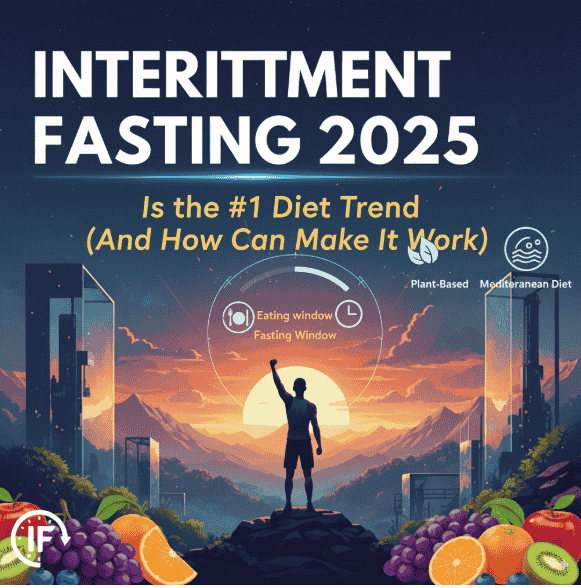Discover why Intermittent Fasting 2025 is the most sustainable weight loss and health trend. Learn fasting methods, benefits, and tips to make it work for your lifestyle.
Intermittent fasting (IF) has taken the world by storm, especially as people search for practical and sustainable ways to lose weight and improve overall health. In 2025, the trend continues to grow because it doesn’t rely on strict meal plans or complicated diet rules. Instead, intermittent fasting focuses on when you eat rather than what you eat, making it easier to adopt in a busy lifestyle.
If you’re curious about how intermittent fasting works, its health benefits, and how to start safely, this guide will give you everything you need to know.
What is Intermittent Fasting?
At its core, intermittent fasting (often called IF) is not a “diet” but a pattern of eating. It alternates between periods of fasting (not eating or eating very little) and eating. Instead of removing entire food groups, it relies on timing.
The most popular intermittent fasting methods include:
- 16/8 Method – Fast for 16 hours daily and eat during an 8-hour window, such as 12 pm–8 pm.
- 5:2 Method – Eat normally for five days, then limit yourself to 500–600 calories on two non-consecutive days.
- Eat-Stop-Eat – Go without food for 24 hours once or twice per week.
- Alternate-Day Fasting – Rotate between eating days and fasting days.
These patterns create a “reset” in your body, allowing it to use stored energy (fat) more efficiently.
How Does Intermittent Fasting Work?
Normally, the body runs on glucose from carbohydrates. But when fasting stretches long enough, those stores run out. That’s when your body turns to fat reserves for fuel through a process called ketosis.
During fasting, your body also experiences important hormonal changes:
- Insulin levels drop, improving insulin sensitivity and lowering diabetes risk.
- Human Growth Hormone (HGH) increases, supporting muscle protection and fat burning.
- Norepinephrine (noradrenaline) rises, slightly boosting metabolism.
Together, these shifts explain why Intermittent Fasting 2025 is more than just hype—it’s a scientifically backed way to promote fat loss and better health.
Key Benefits of Intermittent Fasting
Intermittent fasting has been studied extensively, and the results are promising:
- Weight loss and fat reduction – By reducing eating windows, you naturally eat fewer calories and burn more fat.
- Better metabolic health – Fasting improves blood sugar levels, lowers inflammation, and supports cholesterol balance.
- Heart protection – Research suggests fasting may reduce blood pressure and support cardiovascular wellness.
- Brain health – Some studies link fasting to sharper thinking and lower risk of neurodegenerative diseases.
- Cellular repair and longevity – Fasting activates autophagy, a process that clears damaged cells and encourages renewal.
- Simplicity – No complicated rules or calorie tracking—just time-based eating.
Who Should (and Shouldn’t) Try It?
Most healthy adults can try intermittent fasting safely. However, it’s not recommended for:
- Pregnant or breastfeeding women.
- People with a history of eating disorders.
- Those managing chronic conditions (like diabetes or heart disease) without medical supervision.
If you fall into any of these categories, it’s best to check with a healthcare provider before trying fasting.
Tips for Getting Started
If you’re interested in Intermittent Fasting 2025, here are some practical ways to start:
- Pick the easiest method – The 16/8 style is beginner-friendly.
- Stay hydrated – Drink water, black coffee, or herbal tea during fasting hours.
- Choose quality foods – Fill your plate with whole grains, lean proteins, vegetables, and healthy fats.
- Break your fast gently – Avoid loading up on processed or sugary foods after fasting.
- Stay patient and consistent – Weight loss and energy changes often take weeks.
- Listen to your body – Adjust if you feel dizzy, weak, or overly fatigued.
Busting Common Myths
There are many myths around intermittent fasting. Let’s clear up a few:
- “Skipping breakfast is unhealthy.” – Not everyone needs breakfast. For some, fasting in the morning works better.
- “Fasting slows your metabolism.” – Short-term fasting can actually increase metabolism slightly due to hormonal responses.
- “You’ll lose muscle while fasting.” – With enough protein and strength training, you can maintain or even build muscle.
How to Make Intermittent Fasting Part of Your Life
The secret to making IF sustainable is to adapt it to your lifestyle.
- Set your eating window – Many people prefer 12 pm–8 pm, while others choose 10 am–6 pm.
- Ease into it – Begin with 12 hours of fasting and extend gradually.
- Balance your meals – Focus on protein, fiber, and healthy fats to feel satisfied longer.
- Stay active – Combine fasting with regular workouts for best results.
- Track progress – Use a journal or app to notice changes in energy, mood, and weight.
Final thoughts
Intermittent Fasting 2025 proves that health doesn’t always require strict diets or endless restrictions. Instead, it offers a sustainable, flexible lifestyle shift that supports weight loss, metabolic health, and even long-term wellness.
It may not be perfect for everyone, but for many people, it’s a practical solution that fits into daily life without being overwhelming. If you’re considering fasting, remember to start small, stay consistent, and seek professional guidance if you have health concerns.
With patience and mindfulness, intermittent fasting could be the tool that helps you unlock better health in 2025 and beyond.
Suggested reading
- Harvard Health Publishing – Intermittent fasting: Surprising update
- Johns Hopkins Medicine – Intermittent Fasting: What is it, and how does it work?
- Cleveland Clinic – The Intermittent Fasting Diet Plan
- National Institutes of Health (NIH) – Effects of Intermittent Fasting on Health, Aging, and Disease
